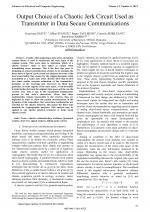| 4/2015 - 8 |
Output Choice of a Chaotic Jerk Circuit Used as Transmitter in Data Secure CommunicationsDATCU, O. |
| Extra paper information in |
| Click to see author's profile in |
| Download PDF |
Author keywords
chaotic communication, nonlinear dynamical systems, observers, signals analysis, sliding mode control
References keywords
chaotic(11), chaos(11), systems(9), cryptography(5), circuits(5), system(4), review(4), physical(4), control(4), barbot(4)
Blue keywords are present in both the references section and the paper title.
About this article
Date of Publication: 2015-11-30
Volume 15, Issue 4, Year 2015, On page(s): 63 - 68
ISSN: 1582-7445, e-ISSN: 1844-7600
Digital Object Identifier: 10.4316/AECE.2015.04008
Web of Science Accession Number: 000368499800008
SCOPUS ID: 84949960782
Abstract
Usually, when analyzing a data series, dynamical systems theory is used to reconstruct the state space of the original system. This work aims to determine which of a chaotic system's states is best suited as output when transmitting secret messages. This is the first step prior to designing an actual communication scheme. As an example, the three states of Sprott's jerk circuit are analyzed in terms of the local observability they ensure for the original dynamics when transmitted as a scalar data series. Results show that its first two states enable accurate estimation of the transmitter's dynamics at the receiving end. However, its third state generates, in some regions of the state space, a non-invertible transformation between the original state space and the one the receiver sees. This is due to the exponential nonlinearities present in this state's derivatives. Given that these nonlinearities remain inaccessible to the receiver, they are neglected in order to allow the partial reconstruction of the dynamics of the transmitter. But, since these nonlinearities are essential for the chaotic behavior, this makes the third state unusable for cryptographic purposes. This analysis may be applied to any bipolar junction transistor or diode based chaotic circuit. |
| References | | | Cited By |
Web of Science® Times Cited: 2 [View]
View record in Web of Science® [View]
View Related Records® [View]
Updated today
SCOPUS® Times Cited: 2
View record in SCOPUS® [Free preview]
View citations in SCOPUS® [Free preview]
[1] High order sliding mode observers and singular value decomposition in communications, Datcu, Octaviana, Dobre, Robert Alexandru, Stanciu, Mihai, 2016 12th IEEE International Symposium on Electronics and Telecommunications (ISETC), ISBN 978-1-5090-3748-3, 2016.
Digital Object Identifier: 10.1109/ISETC.2016.7781063 [CrossRef]
[2] Singular value decomposition to determine the dynamics of a chaotic regime oscillator, Datcu, Octaviana, Hobincu, Radu, Macovei, Corina, 2019 International Semiconductor Conference (CAS), ISBN 978-1-7281-1886-4, 2019.
Digital Object Identifier: 10.1109/SMICND.2019.8923805 [CrossRef]
Disclaimer: All information displayed above was retrieved by using remote connections to respective databases. For the best user experience, we update all data by using background processes, and use caches in order to reduce the load on the servers we retrieve the information from. As we have no control on the availability of the database servers and sometimes the Internet connectivity may be affected, we do not guarantee the information is correct or complete. For the most accurate data, please always consult the database sites directly. Some external links require authentication or an institutional subscription.
Web of Science® is a registered trademark of Clarivate Analytics, Scopus® is a registered trademark of Elsevier B.V., other product names, company names, brand names, trademarks and logos are the property of their respective owners.
Faculty of Electrical Engineering and Computer Science
Stefan cel Mare University of Suceava, Romania
All rights reserved: Advances in Electrical and Computer Engineering is a registered trademark of the Stefan cel Mare University of Suceava. No part of this publication may be reproduced, stored in a retrieval system, photocopied, recorded or archived, without the written permission from the Editor. When authors submit their papers for publication, they agree that the copyright for their article be transferred to the Faculty of Electrical Engineering and Computer Science, Stefan cel Mare University of Suceava, Romania, if and only if the articles are accepted for publication. The copyright covers the exclusive rights to reproduce and distribute the article, including reprints and translations.
Permission for other use: The copyright owner's consent does not extend to copying for general distribution, for promotion, for creating new works, or for resale. Specific written permission must be obtained from the Editor for such copying. Direct linking to files hosted on this website is strictly prohibited.
Disclaimer: Whilst every effort is made by the publishers and editorial board to see that no inaccurate or misleading data, opinions or statements appear in this journal, they wish to make it clear that all information and opinions formulated in the articles, as well as linguistic accuracy, are the sole responsibility of the author.



